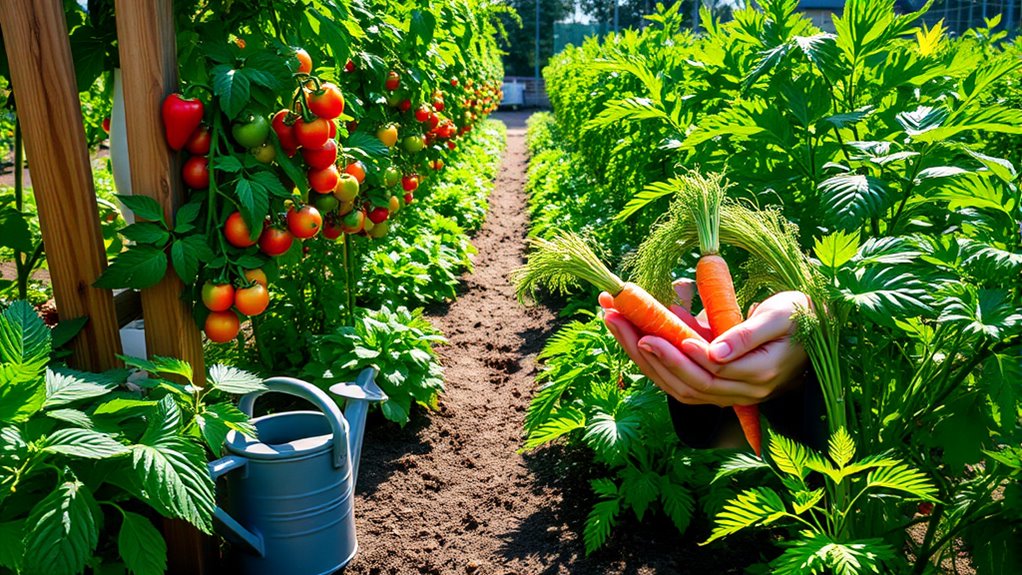To grow your own food, start by selecting easy-to-grow crops based on your climate and available space. Focus on calorie-dense options like beans or potatoes. Maintain healthy soil by adding organic matter and avoiding tilling. Design your garden layout for optimal sunlight and space efficiency. Use essential tools like a hand trowel and pruning shears for maintenance. With these basics in mind, you'll soon discover the joys of home gardening and even more techniques along the way.
Key Takeaways
- Select easy-to-grow vegetables like leafy greens and calorie-dense crops such as potatoes and beans for a productive garden.
- Assess your local climate, space, and growing seasons using the USDA Plant Hardiness Zone Map for optimal plant selection.
- Enhance soil health by adding organic matter, conducting soil tests, and avoiding tilling to maintain structure.
- Implement efficient irrigation systems, such as drip irrigation or soaker hoses, to ensure consistent moisture for your plants.
- Plan your garden layout using graph paper, considering sunlight and plant heights to optimize space and growth.
Crop Selection for Your Garden

How can you choose the right crops for your garden? Start by considering easy-to-grow vegetables like leafy greens, peas, and radishes. These crops thrive in various conditions and offer quick harvests. If you prefer cool-season crops, think about planting broccoli, carrots, and turnips, which flourish in lower temperatures. Broccoli, for instance, is best planted in early spring or late summer to ensure optimal growth and is rich in essential nutrients that support overall health. Additionally, growing your own food in a backyard greenhouse can help create an ideal environment for these crops, as temperature control is crucial for maximizing growth.
For warm-season options, tomatoes, cucumbers, and squash are great choices that love the heat. Don't forget fruits! Strawberries and raspberries are perfect for beginners and yield delicious results with minimal effort. Be sure to plan your garden layout, keeping in mind companion planting to improve growth and deter pests. Additionally, consider high-demand crops that can provide quicker returns on your efforts.
This way, you'll create a fruitful garden tailored to your preferences and local conditions.
Assessing Climate and Space
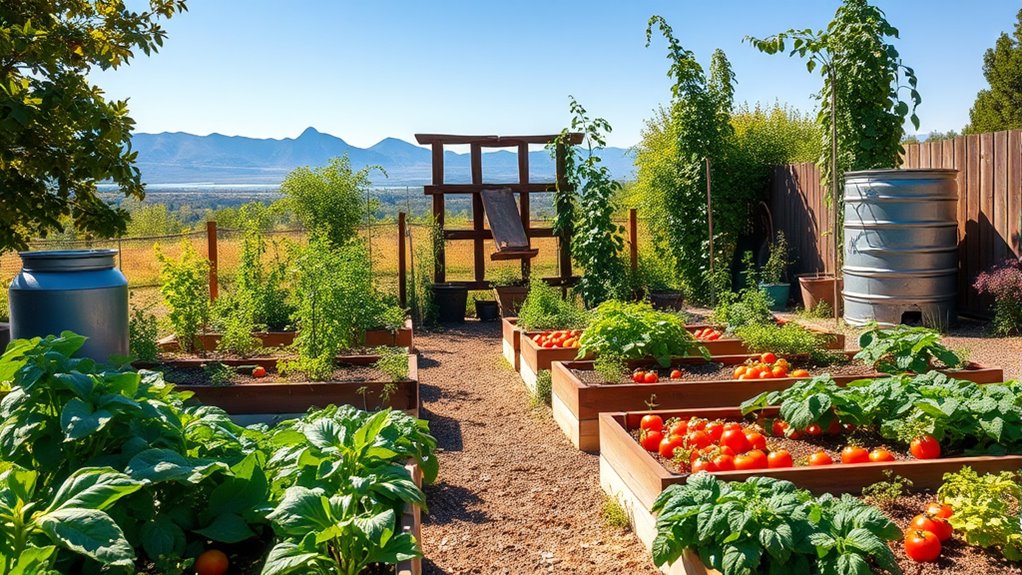
Choosing the right crops is just the beginning; understanding your climate and available space is equally important for a successful garden.
Start by assessing your regional climate using resources like the USDA Plant Hardiness Zone Map to determine suitable plants. Pay attention to temperature variations and precipitation patterns, as these factors directly influence growth. Additionally, optimal wind speeds can contribute to a healthier growing environment by reducing pest populations. Knowing your local growing season can also help you select the best crops that thrive in your specific conditions. Furthermore, understanding color accuracy can aid in selecting plants that will display vibrant colors in your garden. Additionally, being aware of strategic planning can help you effectively manage your gardening efforts and resources.
Don't forget about microclimates created by your yard's topography—some areas may be warmer or cooler than others.
Evaluate your available space: consider container and vertical gardening to maximize your growing area.
Finally, know your local growing season and frost dates to time your planting perfectly. Additionally, consider investing in an air purifier to enhance indoor air quality while you grow seeds and seedlings indoors.
Understanding Family Consumption Patterns
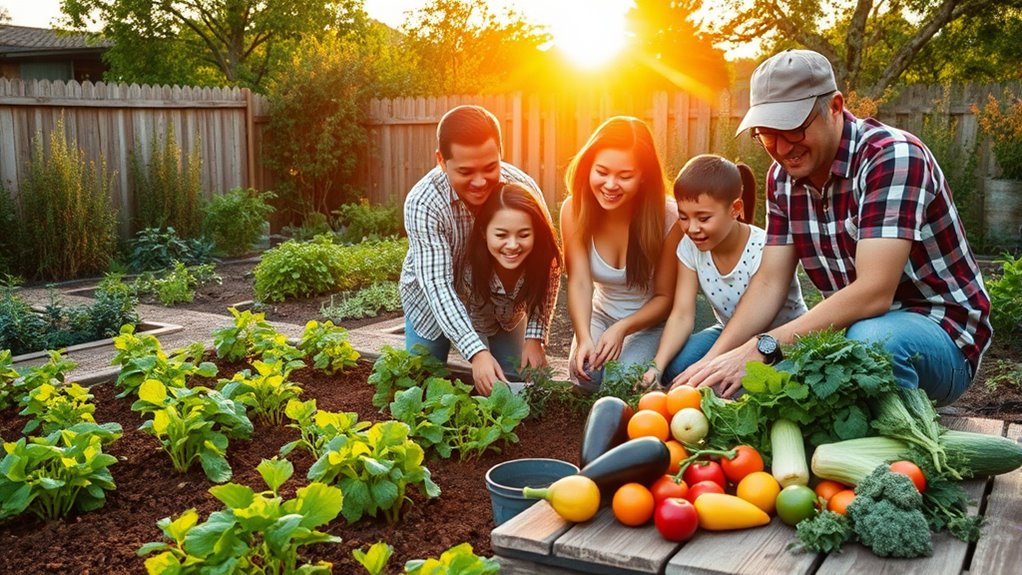
Understanding family consumption patterns is crucial for creating a healthy eating environment at home. When you share meals together frequently, you encourage healthier dietary habits.
Families that dine together three or more times a week see children with better weight management and increased intake of fruits and vegetables. Your own dietary choices directly influence your kids, helping them opt for healthier options like milk and legumes while reducing their intake of sweets. Additionally, nutrition plays a vital role in children's overall cognitive and emotional development, making it essential to prioritize healthy foods at mealtimes. Engaging children with educational toys related to food, such as cooking sets, can further enhance their understanding of nutrition and healthy eating. Moreover, advance directives can guide families in making informed nutritional choices as they navigate health challenges, reinforcing the importance of a balanced diet. Establishing healthy boundaries around food choices can also empower children to make better decisions.
Regular meals not only cut the odds of unhealthy eating but also promote variety in diets. By making mealtime a family affair, you're not just bonding; you're laying the groundwork for lifelong healthy eating habits that can protect against nutritional issues later on. Additionally, fostering open communication about feelings during family meals can enhance emotional well-being and reinforce the importance of healthy choices.
Soil Health and Garden Setup
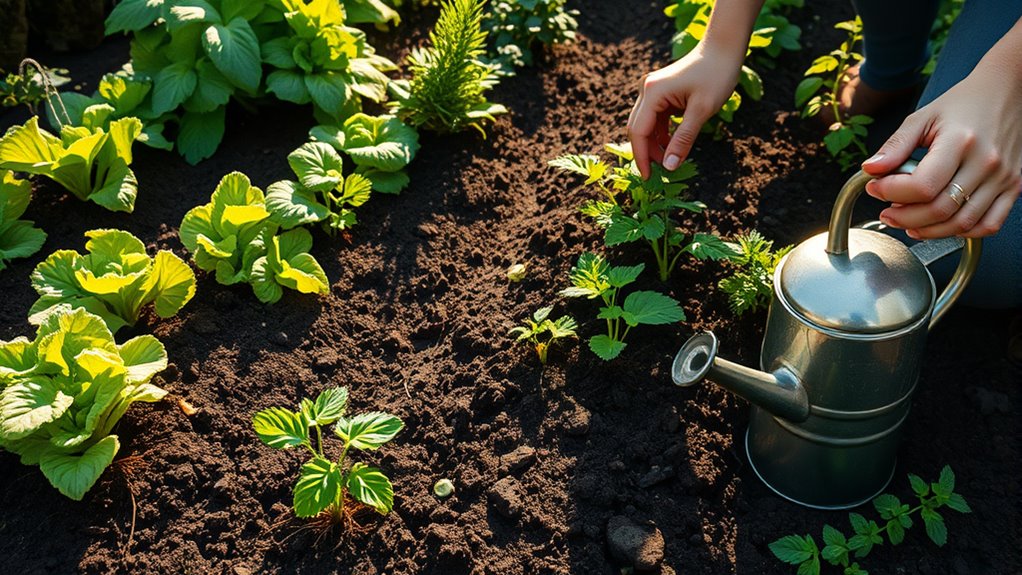
Healthy soil is the foundation of a thriving garden. To ensure your plants flourish, focus on soil composition, which includes physical, biological, and chemical components.
Start by adding organic matter like compost, shredded leaves, or aged manure to improve structure and nutrient availability. Conduct a soil test to assess pH levels and nutrient deficiencies, guiding your amendments. Aim for the optimal pH for your specific plants. Additionally, adding chia seeds can enhance soil health by promoting biodiversity and nutrient cycling. Chia seeds are also known for their nutrient-dense properties, which can further contribute to soil vitality. Furthermore, incorporating high in fiber materials like chia seeds can boost soil structure and water retention.
Avoid tilling; instead, use hand tools to preserve soil structure. Raised beds can help if your soil is poor or contaminated. Designate walking paths around your garden to minimize soil compaction, enhancing root growth. Incorporating omega-rich seeds such as chia seeds can further enhance soil health by promoting biodiversity and nutrient cycling.
Designing an Efficient Garden Layout
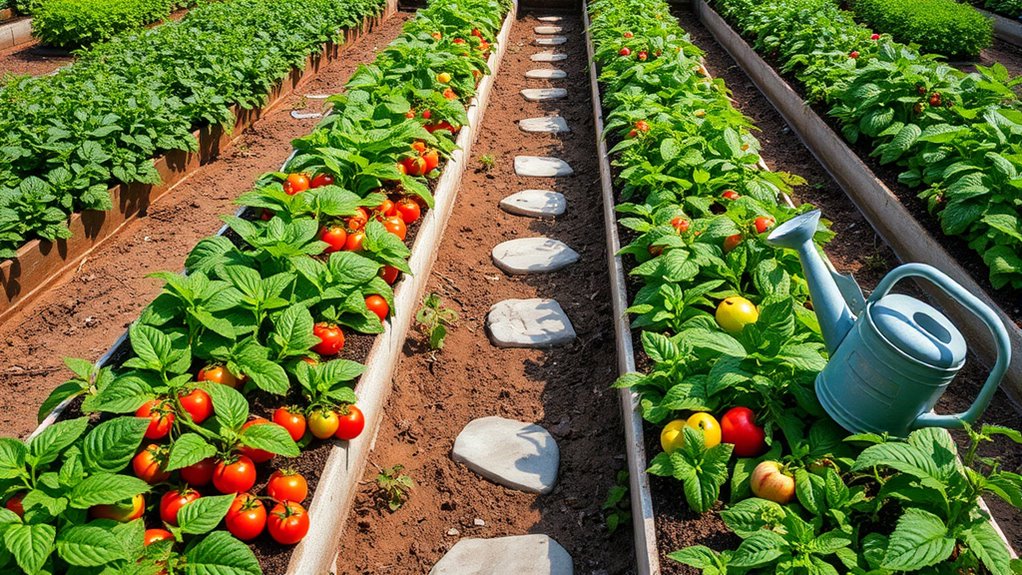
Creating an efficient garden layout is essential for maximizing your growing potential and ensuring easy maintenance.
Start by considering sunlight; most vegetables need 6-8 hours of direct light daily. Use block or square foot gardening to optimize space, and plant taller crops on the north side to prevent shading shorter ones. Best Daisy Varieties can also be planted nearby to attract pollinators like bees and butterflies. Additionally, incorporating natural materials into your garden design, like wood for raised beds, can enhance both aesthetics and functionality. Consider using reclaimed wood for a sustainable touch that aligns with modern farmhouse principles. Utilizing unique planter designs can also add a creative flair to your garden while providing adequate growing space.
Ensure your paths are at least 3 feet wide for easy access. If you have poor soil, raised beds offer better drainage and control.
Consider companion planting to enhance growth and maximize vertical space with trellises. Additionally, incorporating drainage features in your garden beds will help prevent overwatering, ensuring healthier plants.
Don't forget to sketch your layout on graph paper and utilize garden planners or online resources for guidance. These strategies will make your gardening experience more productive and enjoyable.
Choosing the Right Irrigation Systems
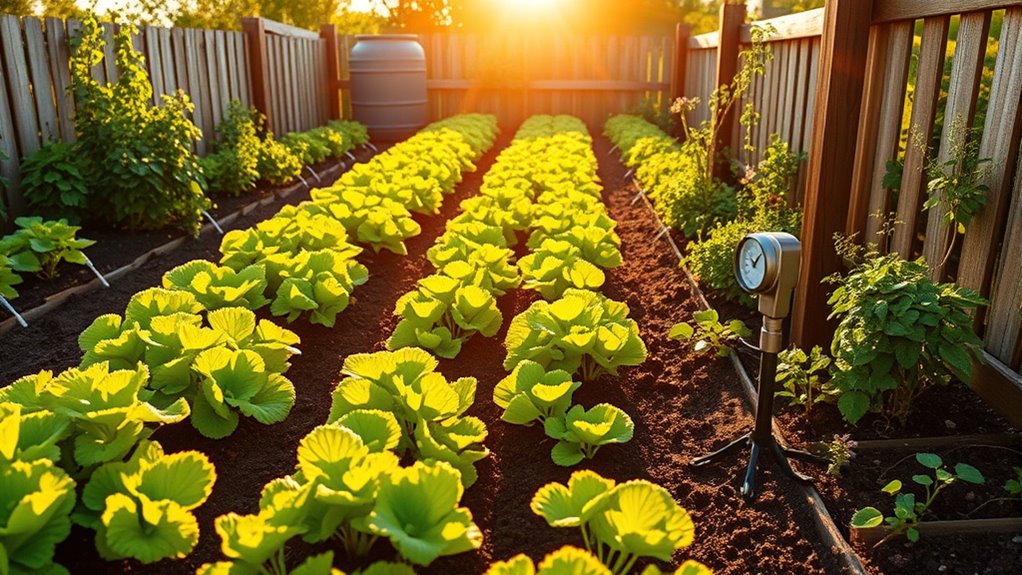
When you're ready to water your garden, choosing the right irrigation system can make all the difference in plant health and water efficiency.
Soaker hoses distribute water slowly and evenly, perfect for diverse gardens. If you're looking for precision, drip irrigation delivers water directly to roots, minimizing waste and boosting crop yields by up to 90%. Additionally, understanding seasonal variations can help you determine the best times to irrigate your garden based on weather conditions.
For larger areas, consider sprinkler systems, though they may waste more water. Self-watering containers are great for hot climates, while sprayers and nozzles provide flexibility for small spaces. Additionally, understanding the importance of effective communication can lead to better decisions about when and how to water your plants.
Selecting Essential Gardening Tools
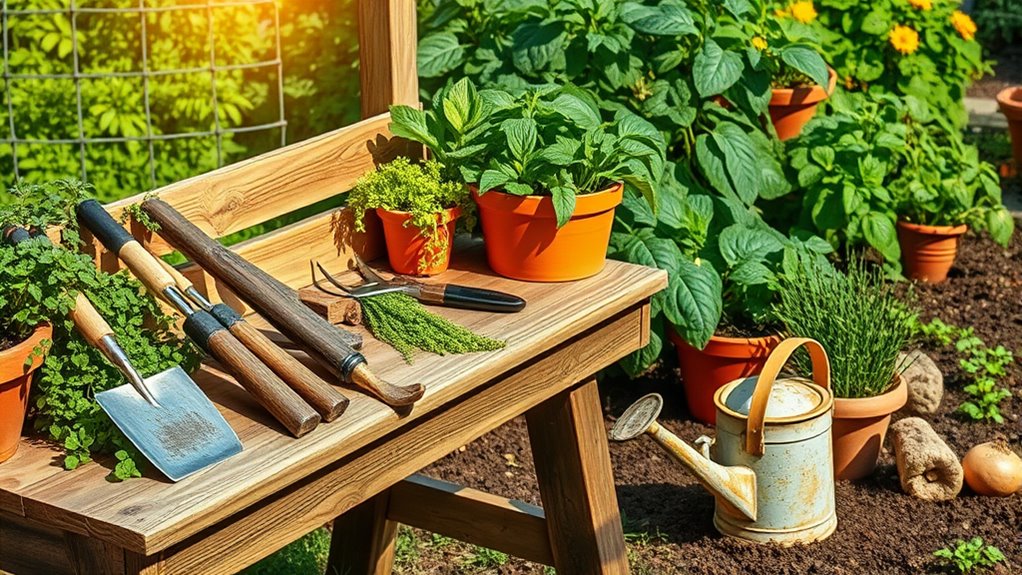
Selecting the right gardening tools can significantly enhance your gardening experience and boost your productivity.
Start with essential hand tools like pruning shears for trimming and gardening gloves to protect your hands. A hand trowel is crucial for planting seeds, while a dibber creates holes for your bulbs. The versatile Hori Hori knife acts as a trowel, knife, and mallet. Incorporating whole foods into your garden can also improve the nutritional value of your meals, and proper diet is essential for both gardeners and their plants. Additionally, ensuring that your plants receive adequate energy monitoring can help maximize their growth.
For larger tasks, include a digging fork for turning soil and a shovel for moving dirt. Don't forget a wheelbarrow for transporting heavy loads.
As you begin seed starting, use grow bags and seed trays to organize your plants.
Finally, a garden hose or spray tank will help keep everything watered efficiently. Additionally, consider incorporating portable camping toilets into your gardening setup for convenience during long hours spent outdoors.
Happy gardening!
Growing Calorie-Dense Crops

With the right tools in hand, you're ready to cultivate a thriving garden, and choosing the right crops can make all the difference.
Focus on calorie-dense options like corn, which offers about 365 calories per 100 grams, and is easy to grow. Beans are another excellent choice, packing protein and fiber, with pinto beans delivering 245 calories per cup.
Potatoes and sweet potatoes provide versatility and essential nutrients, while quinoa is a powerhouse with 368 calories per 100 grams.
Ensure your garden has full sun, well-draining soil, and consistent moisture for optimal growth.
Fast-Growing Crop Options
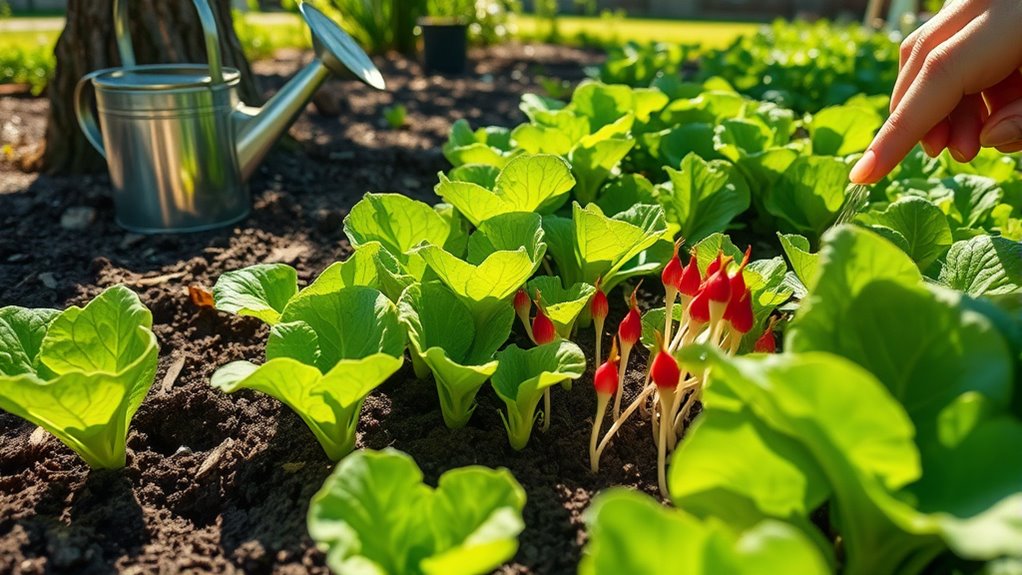
Fast-growing crops can transform your garden into a bountiful source of fresh produce in no time.
Consider planting arugula, which you can harvest in just 25-30 days, or kale, ready in about 40 days. Radishes are another quick option, maturing in roughly 30 days, while spinach can be ready in under 30 days as well.
For a variety of textures, lettuce offers many types that mature within 45-50 days. Depending on your climate, you can also include warm-season crops like cucumbers, which take about 50 days.
Utilize space effectively with container gardening or vertical gardening to maximize your yield.
Preservation Techniques for Long-Term Storage
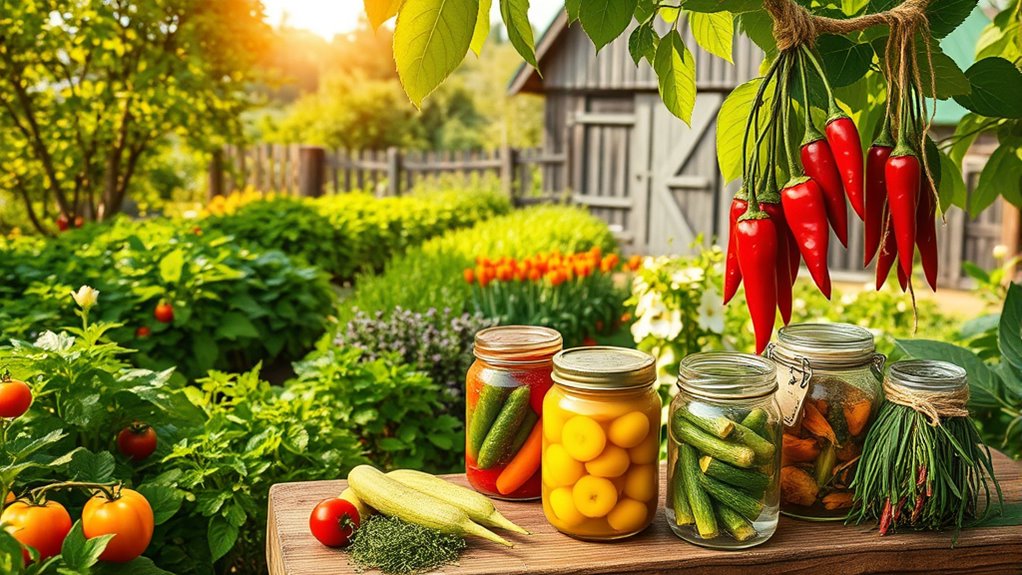
Once you've harvested your fast-growing crops, you'll want to make sure you don't waste any of that fresh produce. Dehydrating is a great option; it removes moisture, preventing bacterial growth. You can use an oven, electric dehydrator, or even a solar dehydrator.
Dehydrating your harvest is an excellent way to preserve freshness and prevent spoilage.
Store dried foods in moisture-proof containers with oxygen absorbers to extend their shelf life.
Canning is another effective method. Seal high-acid foods in a water bath and low-acid foods using pressure canning.
For root vegetables, consider root cellaring in cool, dark spaces. Vacuum sealing also helps by removing air, thus preventing spoilage.
Lastly, fermentation enhances flavor and nutritional value, perfect for items like sauerkraut and kimchi. Choose the technique that best suits your needs!
Frequently Asked Questions
How Do I Deal With Pests Naturally in My Garden?
To deal with pests naturally in your garden, try using essential oil sprays like lavender or peppermint to deter them.
Garlic sprays and neem oil mixtures work effectively too. Install motion-sensing sprinklers and use sticky traps to catch unwanted insects.
Attract beneficial insects by planting dill and marigolds. Additionally, maintain healthy soil and practice crop rotation to prevent pest buildup.
These methods can help keep your garden thriving without harmful chemicals.
What Are the Best Companion Plants for My Crops?
Imagine your garden as a bustling city, where each plant plays a vital role in the ecosystem.
For your crops, consider companions like tomatoes with basil to enhance flavors and repel pests.
Pair cucumbers with marigolds to ward off unwanted visitors, while carrots love the company of onions for pest control.
Remember, planting beans near corn creates a harmonious trio.
How Can I Improve My Garden's Biodiversity?
To improve your garden's biodiversity, start by planting native species that attract local wildlife.
Incorporate various plant layers to create habitats and add water features for more diversity. Use logs and rocks for shelter and choose diverse ground coverings instead of a uniform lawn.
You can also reduce soil disturbance by practicing no-till gardening and using mulch to protect soil.
This approach not only supports wildlife but also enhances the overall health of your garden.
When Is the Best Time to Plant Each Crop?
The best time to plant each crop depends on the season.
For cool-season crops like radishes and lettuce, plant from March to May.
Warm-season crops such as tomatoes and peppers thrive from June to August.
In the fall, you can plant crops like carrots and garlic from September to November.
Be sure to consider your local frost dates and soil conditions to ensure successful growth throughout the year.
How Do Weather Changes Affect My Gardening Plans?
Weather changes are like a fickle dance partner, leading you in unexpected directions with your gardening plans.
Temperature swings can stress your plants, while erratic rainfall might drown or dehydrate them. You'll need to adapt your planting schedule, keeping a close eye on forecasts.
Embrace crop diversity to hedge against surprises, and enhance your soil's resilience.
Conclusion
Growing your own food can feel like having a mini-farm in your backyard, providing you with endless fresh produce. By carefully selecting crops, understanding your space, and maintaining healthy soil, you'll set yourself up for success. With the right tools and a well-planned layout, you'll be harvesting your own delicious bounty in no time. So dig in, get your hands dirty, and watch your garden thrive—your taste buds will thank you for it!
